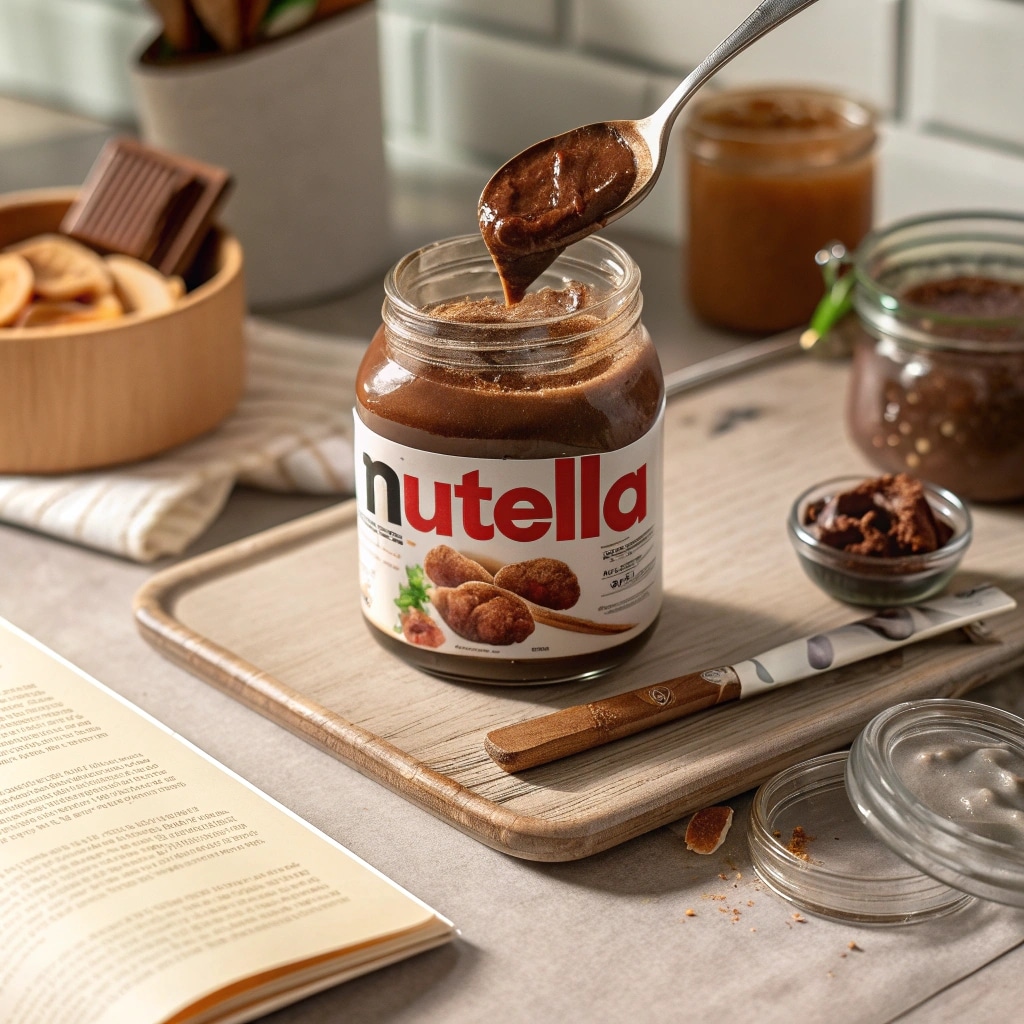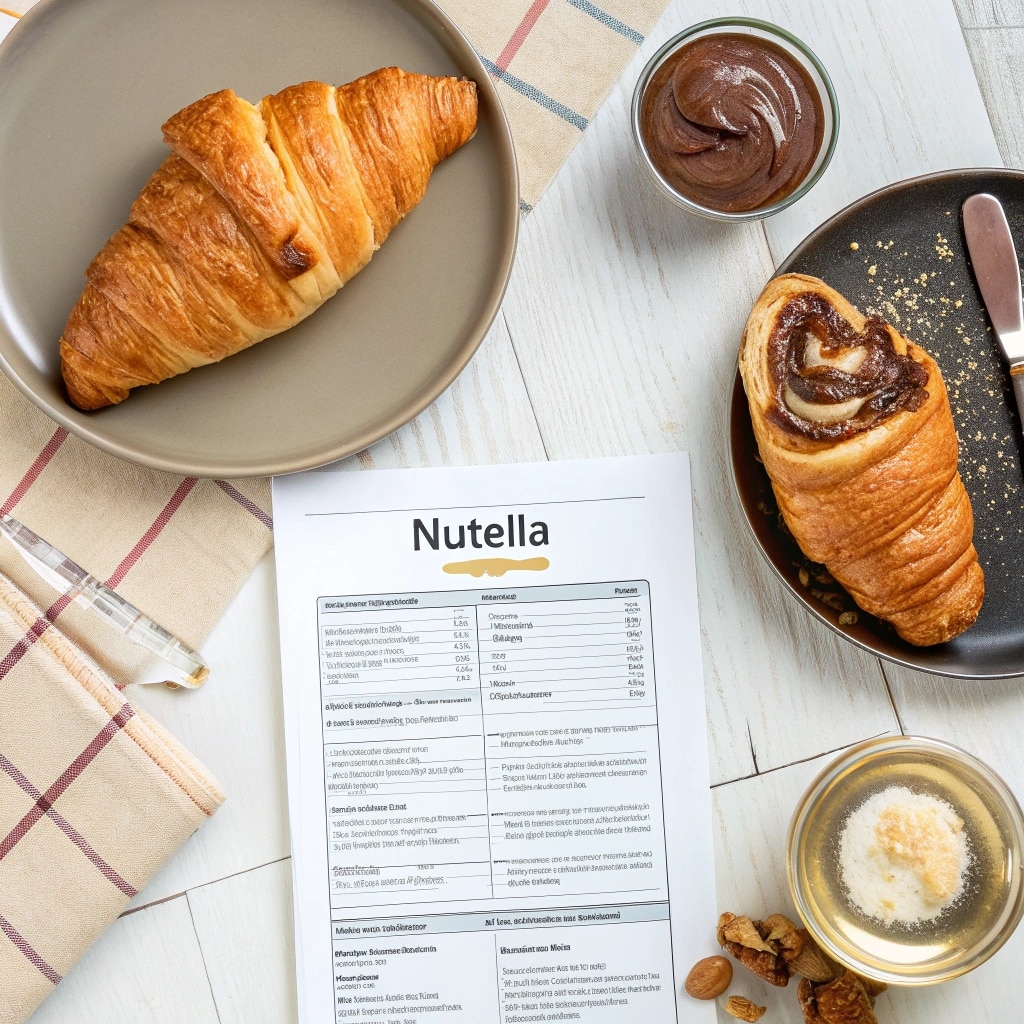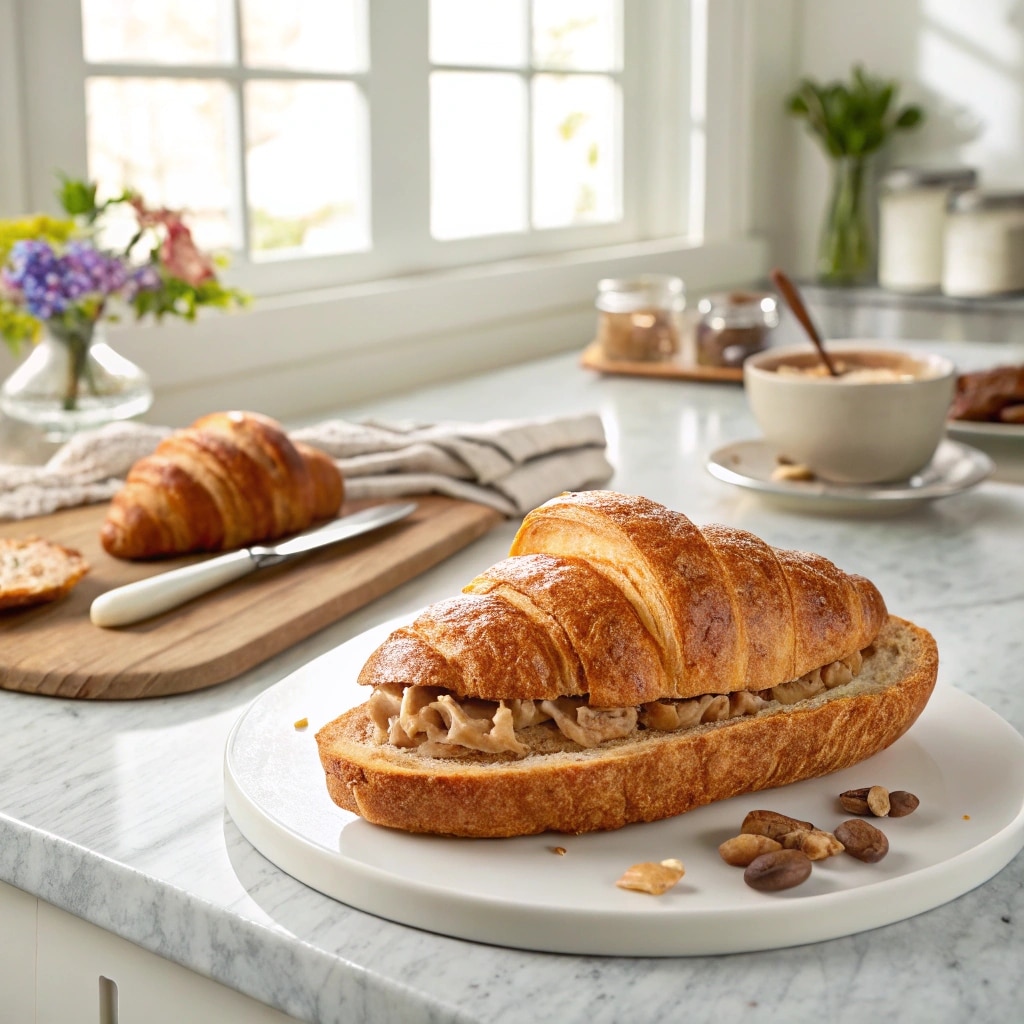When I first baked croissants stuffed with Nutella in my little Asheville kitchen, I didn’t stop to think about Nutella croissant nutrition facts. I just wanted to recreate the joy I felt as a kid in my grandma’s kitchen—rolling out dough, sneaking a taste of chocolate spread, and waiting for the magic to happen in the oven. Over time though, friends began asking: “How many calories are in a croissant with Nutella?” or “Is Nutella healthy at all?” That curiosity led me to explore not just the flavor, but the nutrition behind one of my most requested pastries.
Table of Contents
Introduction to Nutella Croissant Nutrition
What makes Nutella croissants so popular
Nutella croissants are the ultimate comfort food. The combination of buttery pastry and rich chocolate spread creates an irresistible balance of crunch and cream. It’s no wonder people crave them at breakfast or as a mid-day treat. Beyond flavor, there’s nostalgia. Nutella has been a staple in kitchens for decades, so when it’s folded into a flaky croissant, the result feels both familiar and luxurious.
But popularity often comes with curiosity. As cafés and bakeries showcase Nutella-filled pastries alongside almond or chocolate croissants, people want to know: what are the Nutella croissant nutrition facts compared to other pastries? Are they higher in sugar? Do they count as high-calorie breakfast foods? These questions matter, especially for anyone tracking carbs in croissants or trying to limit daily sugar intake.
I remember testing mini croissants with Nutella versus bakery-sized ones. The smaller portions satisfied a sweet craving while keeping calories lower. A mini croissant with Nutella might be around 200 calories, while a full bakery croissant stuffed with chocolate spread can climb above 450 calories. No matter the size, one thing is clear—Nutella croissant nutrition facts vary depending on portion, filling, and preparation.
For those who love indulgent desserts like croissant Nutella bread pudding, this pastry is a cousin in both flavor and calorie count. It’s decadent, yes, but also deeply satisfying.
Why nutrition facts matter for indulgent pastries
As a baker, I’ve learned that sharing pastry nutrition facts doesn’t take away from the joy—it adds perspective. A standard croissant is already rich in butter and refined flour, usually landing around 250–300 calories. Add Nutella, and suddenly you’re looking at a much higher calorie number. With about 200 calories per two tablespoons, Nutella adds sugar, fat, and carbs to the mix. That’s why knowing Nutella croissant nutrition facts helps balance indulgence with health.
For example, Nutella has roughly 21 grams of sugar per serving, which contributes heavily to daily sugar intake. Combine that with saturated fat in pastries, and you understand why dietitians caution moderation. It’s not about labeling croissants as unhealthy—it’s about understanding where they fit. If you’re counting macros, you’ll want to factor in Nutella calories per tablespoon, carbs in croissants, and overall fat content.
When I crave variety, I sometimes reach for savory options like focaccia sandwiches. They offer balance and keep me from overloading on sweets. But when I do indulge in Nutella, I enjoy it fully, armed with the knowledge of Nutella croissant nutrition facts. That way, the treat feels intentional, not guilty.
Understanding Nutella Croissant Calories
Average calories in a Nutella croissant
A croissant with Nutella can range from light to very indulgent depending on size and filling.
| Type | Calories |
|---|---|
| Mini Croissant + 1 tbsp Nutella | ~200–220 |
| Medium Croissant + 2 tbsp Nutella | ~400–450 |
| Bakery-Sized Croissant + 3 tbsp Nutella | ~550–600+ |
The same lesson applies to other indulgent desserts, like my red velvet waffle cake. A small slice is easy to fit into your day, but the larger the serving, the bigger the impact on your calorie budget.
Key factors that affect calories
- Size: Mini vs bakery croissant calories can double.
- Filling amount: 1 tbsp Nutella = ~100 calories; 3 tbsp = 300 calories.
- Toppings: Powdered sugar, drizzle, or nuts add extra calories and sugar.
- Comparison:
- Croissant vs bagel calories: Bagels are heavier in carbs, while croissants lean higher in fat. If you want a lighter swap, recipes like cottage cheese bagel recipes offer more protein with fewer indulgent fats.
- Nutella vs peanut butter nutrition: Peanut butter has more protein and less sugar than Nutella. You’ll taste the difference in desserts like peanut butter cream cake filling, which is richer in protein but lighter on sugar.
Takeaway
- Understanding Nutella croissant nutrition facts helps you enjoy them without guilt.
- A Nutella croissant can be a 200-calorie snack or a 600+ calorie indulgence.
- Portion size and spread amount are the biggest calorie drivers.
Detailed Nutella Nutrition Facts
Calories, fat, sugar, and carbs in Nutella spread
When I first started reading labels, I was shocked at the Nutella sugar content. I had always thought of Nutella as a hazelnut spread, but sugar is actually the first ingredient. One serving—two tablespoons—contains about 200 calories, with most of that coming from sugar and fat.

| Nutrient | Amount | % Daily Value* |
|---|---|---|
| Calories | 200 | — |
| Total Fat | 11g | 14% |
| Saturated Fat | 4g | 20% |
| Carbohydrates | 22g | 8% |
| Sugar | 21g | 42% |
| Protein | 2g | — |
*Percent Daily Values are based on a 2,000-calorie diet.
Comparing Nutella to other chocolate spreads
Nutella is famous for flavor, but nutritionally it’s closer to a dessert than a protein-rich spread. Here’s how it stacks up against peanut butter and a dark chocolate nut spread (per 2 tbsp serving):
| Spread | Calories | Protein | Sugar | Fat |
|---|---|---|---|---|
| Nutella | 200 | 2g | 21g | 11g |
| Peanut Butter | 190 | 7g | 3g | 16g |
| Dark Chocolate Nut Spread | 180 | 4g | 10g | 12g |
Quick Takeaways:
- Nutella: Highest in sugar, lowest in protein.
- Peanut butter: More protein, less sugar (a better choice for satiety).
- Dark chocolate spread: Middle ground, less sugar than Nutella, still indulgent.
That’s why whenever I share Nutella croissant nutrition facts, I emphasize that your choice of filling makes a big difference. Swapping Nutella for peanut butter or a lower-sugar spread can cut sugar dramatically while boosting protein.
Croissant Nutrition Breakdown
Standard croissant nutrition facts
A plain croissant is lighter than it looks but still high in fat and carbs. Here’s the breakdown for a medium croissant (67g):
| Nutrient | Amount | % Daily Value* |
|---|---|---|
| Calories | 272 | — |
| Total Fat | 14g | 18% |
| Saturated Fat | 8g | 40% |
| Carbohydrates | 31g | 11% |
| Sugar | 6g | 12% |
| Protein | 5g | — |
*Based on a 2,000-calorie diet.
Butter and refined flour impact on calories
- Butter: Croissants get their flaky layers from butter, which explains the high saturated fat. One croissant = ~40% of daily limit.
- Flour: Made with refined flour, croissants digest quickly, leading to carb spikes.
- Comparison: Croissant vs bagel calories—bagels are heavier in carbs, croissants in fat. Both are calorie-dense.
- With Nutella: Adding spread raises totals fast, which is why Nutella croissant nutrition facts highlight sugar + fat as key concerns.
Nutella Croissant Nutrition Facts (Complete Breakdown)
Calories, fat, protein, and sugar per serving
When you combine a plain croissant with Nutella, the calories and sugar increase quickly. Here’s an average breakdown for a medium croissant (67g) filled with 2 tbsp Nutella (37g):
| Nutrient | Amount | % Daily Value* |
|---|---|---|
| Calories | 472 | — |
| Total Fat | 25g | 32% |
| Saturated Fat | 12g | 60% |
| Carbohydrates | 53g | 19% |
| Sugar | 27g | 54% |
| Protein | 7g | — |
*Based on a 2,000-calorie diet.

Daily value percentages at a glance
- Calories: Nearly 25% of a 2,000-calorie diet.
- Fat: Over 30% of daily allowance; high in saturated fat.
- Sugar: More than half of daily sugar intake in one pastry.
- Protein: Moderate (7g), but not enough to offset sugar + fat.
- Carbs: At 53g, it’s similar to eating a large bagel with spread.
This shows why Nutella croissant nutrition facts matter—one pastry can take up a big portion of your daily fat and sugar allowance.
How Many Calories Are in Different Sizes of Croissants with Nutella?
Mini vs Medium vs Bakery-Sized
Size makes the biggest difference in Nutella croissant nutrition facts.
| Croissant Type | Croissant Calories | Nutella Filling | Total Calories |
|---|---|---|---|
| Mini (40g) | 150 | 1 tbsp (100) | ~250 |
| Medium (67g) | 270 | 2 tbsp (200) | ~470 |
| Bakery-Sized (90g+) | 350 | 3 tbsp (300) | ~650 |
Homemade vs Store-Bought vs Café Croissants
Where you get your croissant also changes the numbers:
- Homemade: Usually smaller, less butter, lighter on calories (~350 with Nutella).
- Store-Bought (packaged): Often denser, higher in fat, ~450–500 calories each.
- Café/Bakery: Largest portions, often with extra filling, ~600+ calories.
Quick Takeaways
- Mini croissants are the best option if you want a lighter treat.
- Café versions are usually the highest in croissant calories due to size and toppings.
- Nutella croissant nutrition facts show that size + spread amount are the main calorie drivers.
Are Nutella Croissants Healthy or Unhealthy?
According to Nutella croissant nutrition facts, these pastries are high in sugar, saturated fat, and calories, which makes them an indulgence rather than a health food. They can still be enjoyed in moderation if portion size is controlled.
Nutritional Pros
- Energy Boost: Nearly 500 calories per serving provide quick fuel.
- Satisfying Flavor: Combines butter and chocolate spread for comfort.
- Protein Contribution: Around 7g of protein per croissant.
- Flexible Portions: Mini croissants are lighter and easier to fit in.
Nutritional Cons
- Sugar: ~27g per serving, more than half of the daily sugar intake limit.
- Saturated Fat: ~12g per croissant (60% of daily value).
- Refined Flour: Croissants digest quickly and spike blood sugar.
- High-Calorie: Large bakery croissants can reach 600+ calories.
Croissants with Nutella aren’t “healthy,” but the Nutella croissant nutrition facts make it clear they can still be part of a balanced lifestyle when eaten occasionally, in smaller portions, or with healthier swaps.
Tips for Enjoying Nutella Croissants Without Guilt
Yes, you can enjoy Nutella croissants without guilt — the key is portion control, smart pairings, and healthier swaps when possible.
Portion Control & Mindful Eating
- Choose a mini croissant instead of a bakery-sized one.
- Share a larger croissant or save half for later.
- Pair with black coffee or tea instead of sugary drinks.
- Enjoy slowly — mindfulness reduces the urge for seconds.
Healthier Alternatives and Swaps
Here’s how simple swaps can lower calories and sugar while keeping flavor:
| Instead of | Try | Benefit |
|---|---|---|
| Bakery-sized croissant | Mini croissant | Cuts ~300 calories |
| 2–3 tbsp Nutella | 1 tbsp Nutella | Reduces sugar by 14g |
| Nutella filling | Dark chocolate spread or peanut butter | More protein, less sugar |
| Plain croissant | Whole grain croissant (if available) | Adds fiber, steadier energy |

Nutella croissants don’t have to mean guilt. Smaller sizes, mindful eating, and smart swaps make them easier to fit into your diet. Remember: indulgence is part of balance.
FAQs on Nutella croissant nutrition facts
How many calories are in a croissant with Nutella?
A medium croissant with 2 tablespoons of Nutella has about 450–470 calories.
Smaller croissants can be closer to 250 calories, while bakery-sized ones with extra filling may exceed 600.
What are the Nutella nutrition facts?
The Nutella croissant nutrition facts highlight that two tablespoons of Nutella provide about 200 calories, 21g sugar, 11g fat, and 2g protein. This makes Nutella higher in sugar compared to other spreads.
How many calories are in 1 croissant?
According to Nutella croissant nutrition facts, a plain medium croissant (67g) contains about 270 calories. The number increases when filled with Nutella or other spreads.
How unhealthy are croissants?
Croissants are considered indulgent pastries because they are high in butter, refined flour, and saturated fat.
They aren’t “healthy” but can be enjoyed occasionally as part of a balanced diet.
Conclusion
Nutella croissants are a delicious indulgence, but the Nutella croissant nutrition facts show they’re best enjoyed occasionally and in smaller portions.
- A medium croissant with Nutella averages 450–470 calories, while bakery-sized options can exceed 600.
- The main concerns are high sugar (27g) and saturated fat (12g), which make croissants one of the more indulgent pastries.
- Knowing the nutrition facts for croissants and Nutella helps balance indulgence with healthier meals.
- Choosing mini croissants, reducing the serving size of Nutella spread, or swapping in dark chocolate or peanut butter are simple ways to enjoy the flavor with fewer calories.
- Compared to other high-calorie breakfast foods, Nutella croissant nutrition facts remind us that portion control is the difference between a light treat and a heavy meal.
By understanding Nutella croissant nutrition facts, you don’t have to give up this pastry. Instead, you can enjoy it mindfully — a flaky, chocolate-filled treat that fits into a balanced lifestyle.
Want more sweet inspiration? Follow me on Facebook and Pinterest where I share cozy, easy-to-make baking recipes just like this one. Every bite is a warm hug. Let’s bake something beautiful together.
